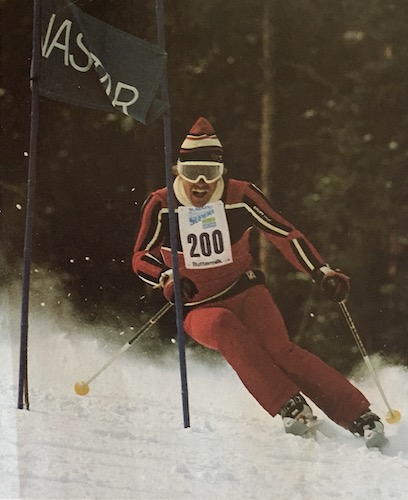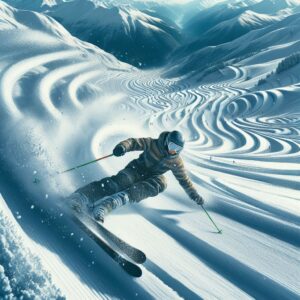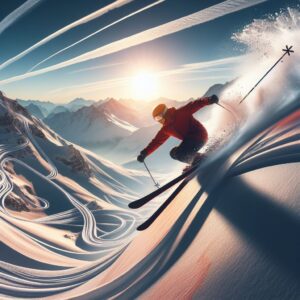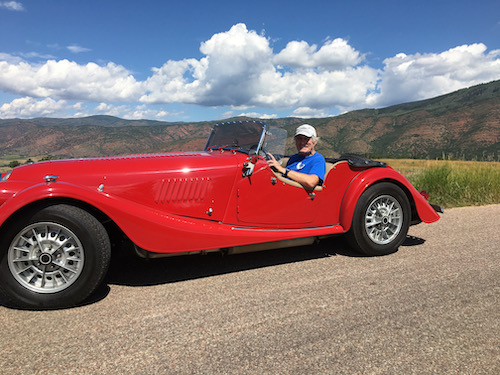The Art of Skiing / Instructor: Jonathan Teuscher

In the early to mid-80s, it was my good fortune to meet Robert Georgi and Jonathan Teuscher. Both were (and are) remarkable ski instructors. Both thought a great deal about their sport and also, about how best to teach it.
The Five Levels
The first time we met, I shared with them my “five levels” table, suggesting that the five levels might mark the route to becoming an expert skier.
NO MIND – In the beginning, the would-be skier says, I’m going to try not to fall. That’s my goal. I just don’t want to break anything. And in so saying the student adopts an amoeboid, survival-based, approach-avoidance attitude toward the sport.
HIVE MIND – Then, with improvement, the attitude changes. The student says: I’m going to do exactly as the instructor prescribes. I’m going to stay in the instructor’s tracks, modeling and mirroring her every move. The student embraces the experience programmed by authority.
HEROIC MIND – As the skill of the student increases, he (or she) sooner or later leaves the instructor. The restrictiveness of the class experience is abandoned for the sake of the self. I can make my own way down this mountain. I’ll meet the rest of you at the lift.
POETIC MIND – Then, with increasing success and diminishing fulfillment, the student awakens to the flow. Wait a minute, it’s how I go down the mountain that really matters. I’m going to put so much rhyme and reason into this descent they will have to peal the smile off my face! The student becomes an acrobat, a downhill racer, a dolphin diving and returning to the surface.
MATURE MIND – Finally, tired of his play, the student remembers his desire only to feel unlimited, and so, in a certain sense, gives up thinking altogether, submitting himself fully to the factors of snow, slope, wind and x-squared. It is as if he says: The mountain does the thinking and I ski its line of thought. It’s at that point that he becomes the master of his own descent.
These five levels or stages, I proposed, could mark the stages to mastery regardless of art or profession. Change specific terms within each step and you could be talking about the architect, the chef, the wind surfer, the painter, the sculptor, etc., as each travels the same course to mastery. And then, it is but a small step to seeing each discipline as a metaphor.
The skier as metaphor
This is the topic we often discussed—Georgi, Teuscher, and myself: the skier as metaphor. Learn to ski, master it to the extent you can, and your pursuit will remind you of what you are attempting to do with the self.

There is perhaps nothing new here. It’s just that skiing is particularly rich metaphorically. Buckminster Fuller said that expert skiers are demonstrating a high degree of proficiency at the angular valving of gravity. So, too, the individual who has learned to deal effectively with the gravity of everyday life.
The skier as metaphor… That has been one of our topics, but so, too, the art of teaching. Remarkable teachers—both Robert and Jonathan are remarkable teachers—ask: How can I teach most effectively the skill I am trying to teach?
Re-minding the instructor
Consider the following… Learning to ski is something the beginner looks forward to but not without trepidation. Patience on the part of the instructor, careful coaxing, the right sequencing of steps, all are essential to bringing the student along.
With this in mind, the Aspen Ski School has on one occasion taken its instructors to the top of the mountain and required them to put on cross-country skis. With downhill skis, these instructors are at home, able to sail down the mountain. With cross-country skis, however, they are unsure of themselves. Making their way down the mountain puts them in touch with the fear and hesitation their students will experience when classes begin.

This is a practice that benefits both instructor and student. The instructor remembers what the student is likely to be experiencing the first week of class and so, is more likely to deliver the support that is needed. And the student feels that his or her “beginner status” is understood, and to that additional degree, the teaching process in capable hands.
Self-mastery
Of course, the question that can be asked at this point—the question that returns us to the skier as metaphor—is this: What, in fact, is the instructor teaching? The obvious answer, of course, is skiing. Perhaps teaching—through many lessons and a series of instructors—the mastery of skiing. And this so that the thrill and joy of skiing can be enjoyed to its fullest.
But is there something more? Both Mr. Georgi and Mr. Teuscher have said on occasion something like the following: There comes a point when all the requisite skills have been acquired. The skier can now ski the mountain without putting himself or others at risk. He reads the situation moment-to-moment, helping others as needed and steering clear of trouble. For those lacking his skill, he may be an inspiration as he is able to express himself as he wishes. He skies the mountain creatively.
This enriches the metaphor. For to be free to express oneself creatively—to have the skills and confidence to do so—is no doubt among the deepest of human yearnings. To be out in the world, confident that you will not harm others or allow yourself to be harmed, confident that you can deal constructively, creatively with most every situation that arises. This is self-mastery, or an approximation to it.

The mountain does the thinking
Expert ski instructors help students acquire whatever mastery is theirs to acquire. They teach perspective as well as technique. Perspective because while they may be working with a single student, they are trying to make the mountain safe for everyone.
As for the student who goes through all that he must go through in pursuit of mastery, that student, if reflective at all, has learned a great deal about life. He now sees in skiing the living of his life, and in the living of his life, he sees the art of skiing. He sees two things at once. William Blake’s “double vision”. Expert instructors, like Robert Georgi and Jonathan Teuscher, teach both the skill and the metaphor. The metaphor without hardly trying. It comes along naturally. You can be in crowd. New York City… You remember: Nothing reckless. Harm no one, including yourself. Enjoy the experience. The mountain does the thinking.
FAVORITE QUOTE:
“Conduct is the final thing.”
Affred Nock


David Thomas, PhD
Addendum
The picture that begins this exhibit is taken from the following article appearing in Ski Magazine, 1980. NASTAR stands for NAtional STAndard Race. It is “the largest public grassroots ski racing program in the world.” It is a skiing program for recreational racers of all ages. It’s aim, as the title of the article suggests, is to foster personal development and growth through the ski racing experience.
NASTAR: A Matter of Bettering Yourself, Not Just Beating Someone Else
Only the racing bibs they wear distinguish these skiers from all the other recreational skiers on the mountain.
The bibs identify the skiers as NASTAR “racers” but if you take a closer look, “racer” might strike you as being something of a misnomer: this group of “racers” does not quite fit the popular image of how ski racers should appear—the group includes men and women; there are beginners mixed in with the experts; individuals who look as if they just stepped out of the fashion pages and skiers in traditional levis and baseball hats; there are “racers” as young as 2 1/2 and “racers” in their sixties; there are those who dream of NASTAR medals, or even greater glory, and those who just want to add a new element of excitement to their ski holiday.
They are recreational skiers such as you and I but at this moment as they stand near the start of a NASTAR course, they are “racers” and they share a special emotion —an energizing blend of anticipation and apprehension.
In just a few minutes as each skier completes the NASTAR course, that emotional blend will have been reduced to a single ingredient—excitement.
The apprehension is gone now, replaced by a sense of achievement that is the private property of those who hear a challenge and accept it.





